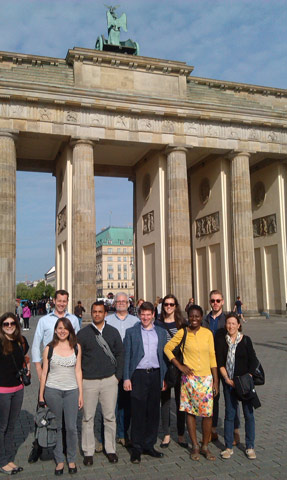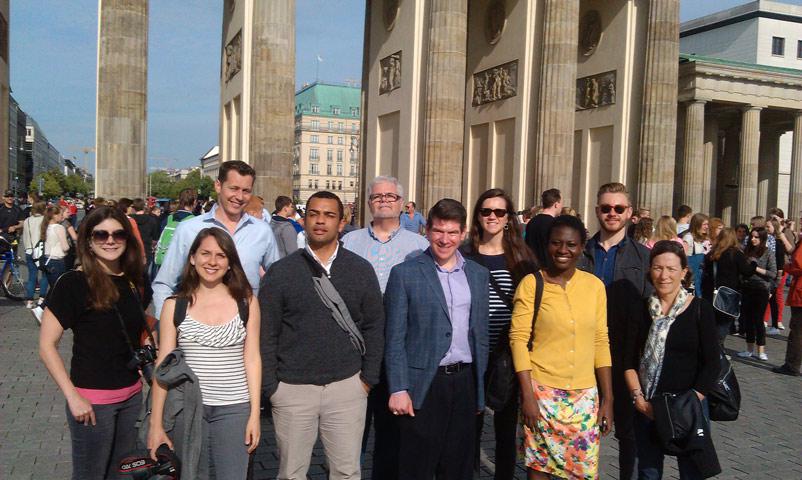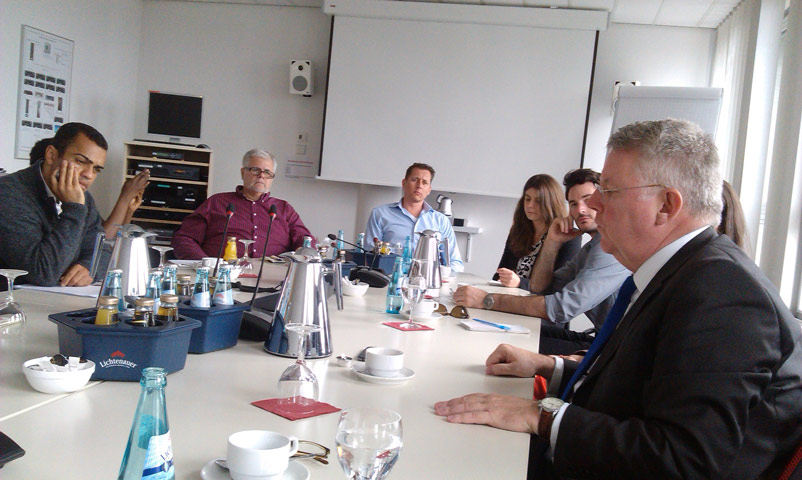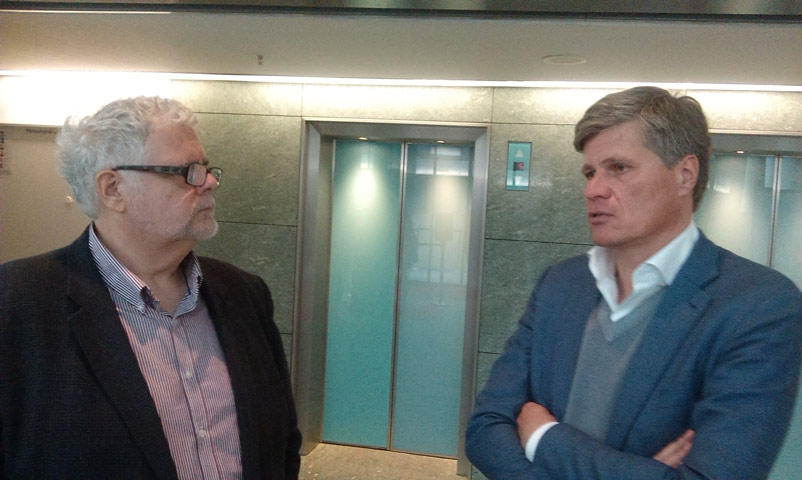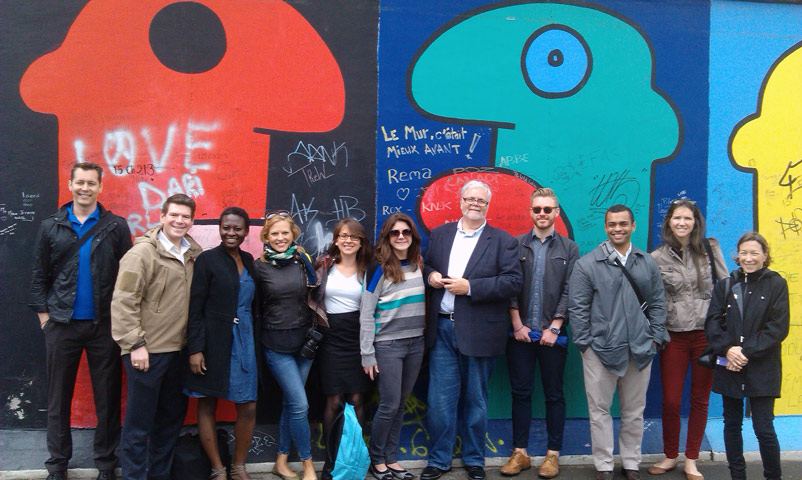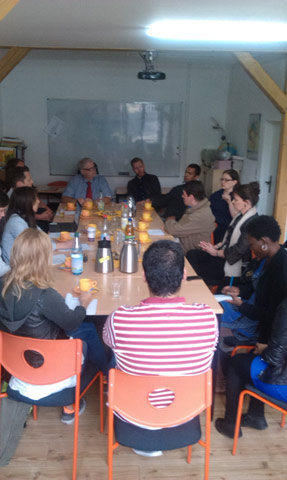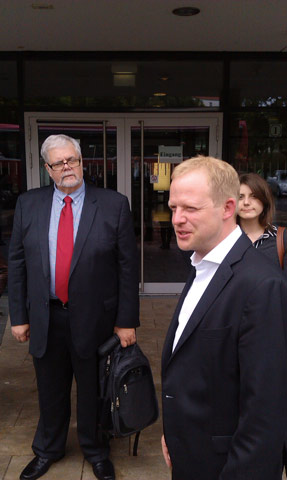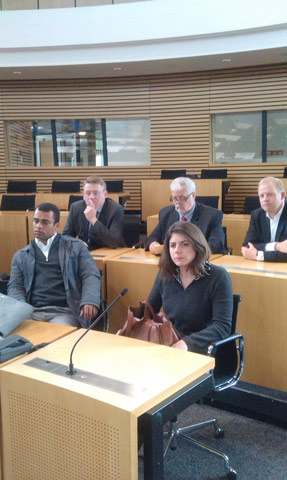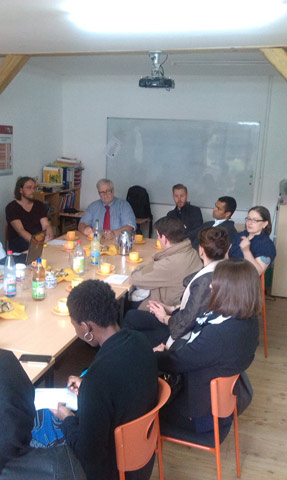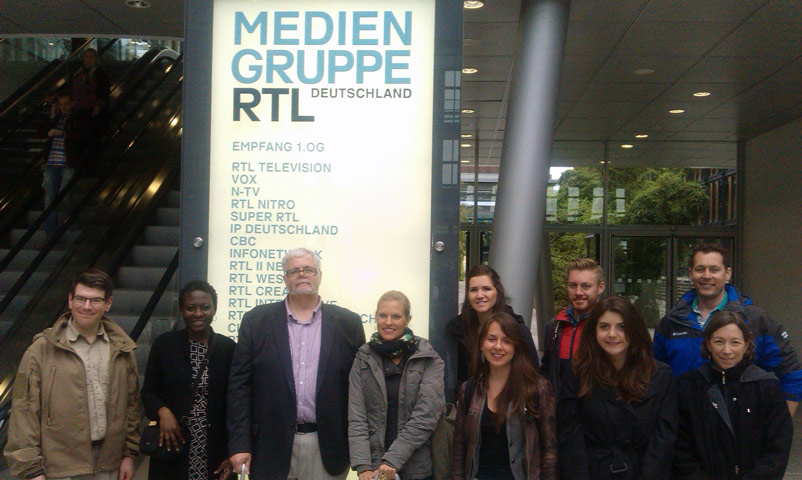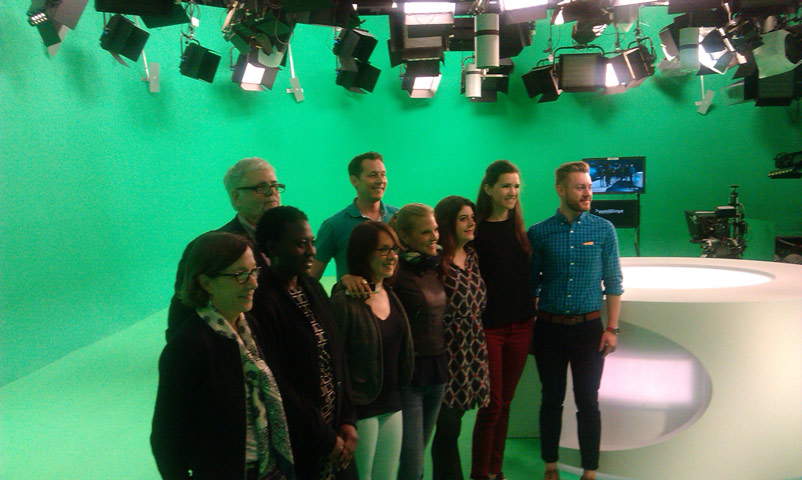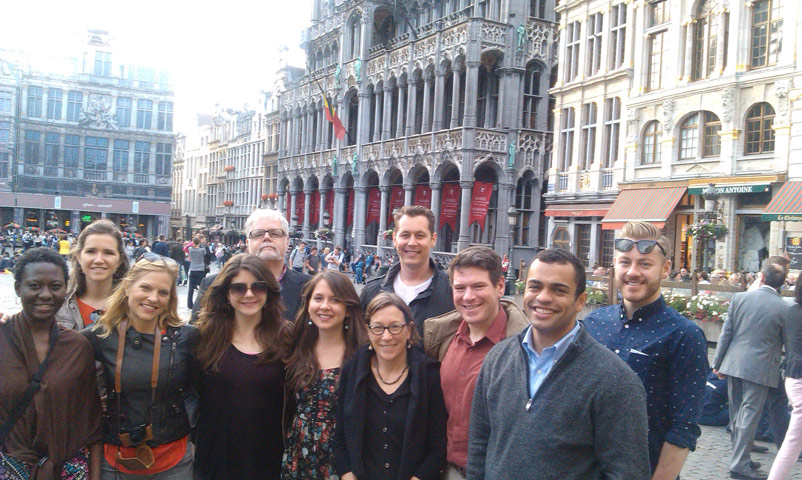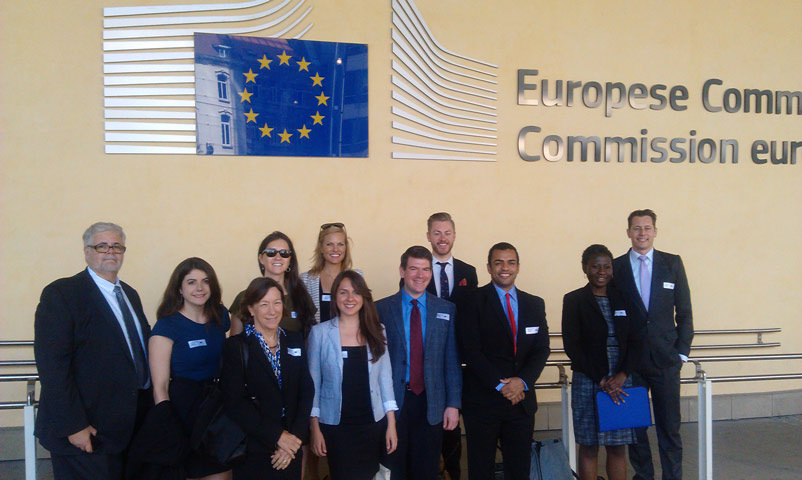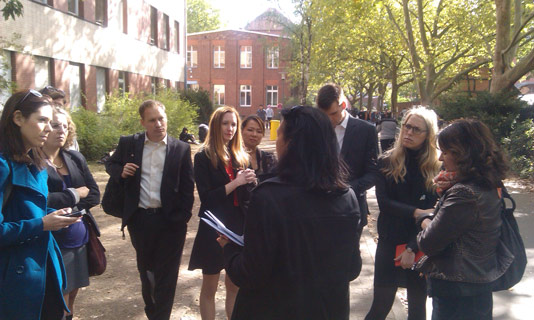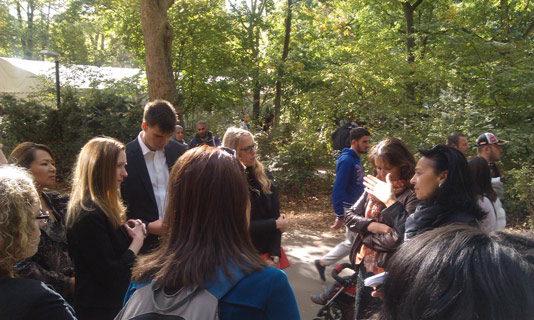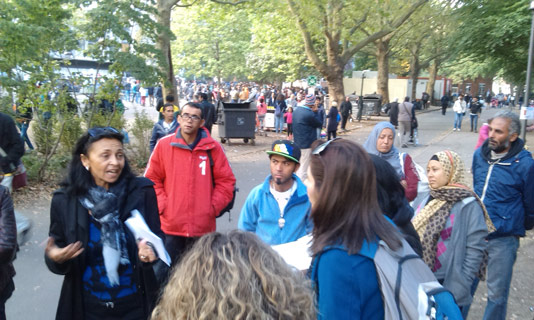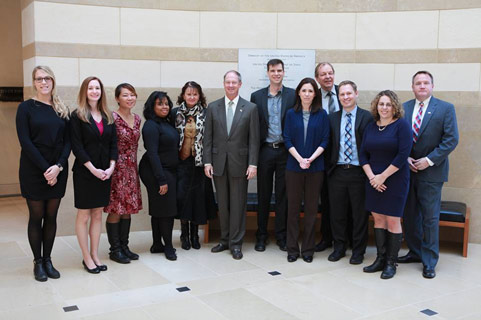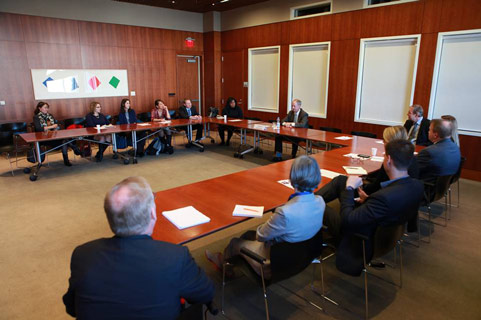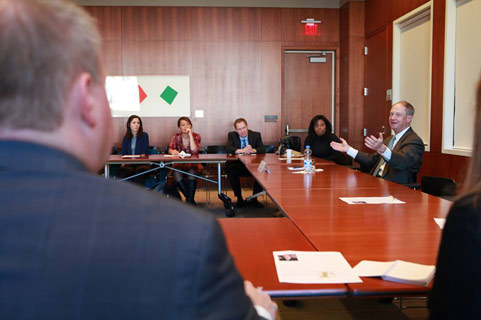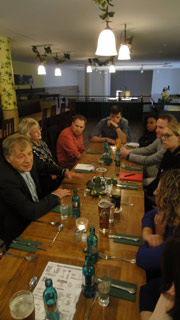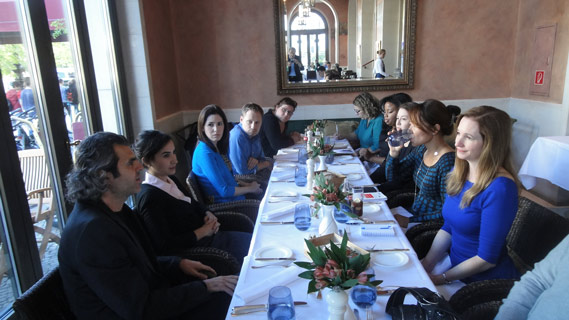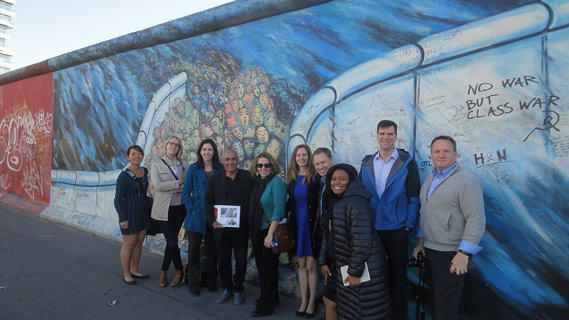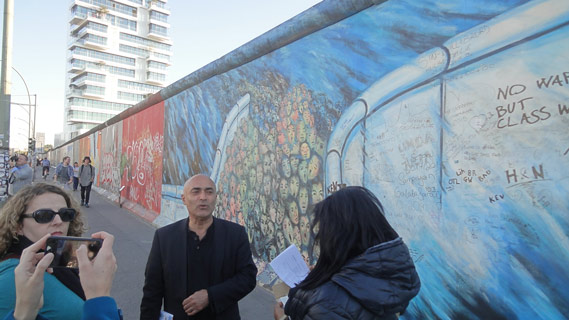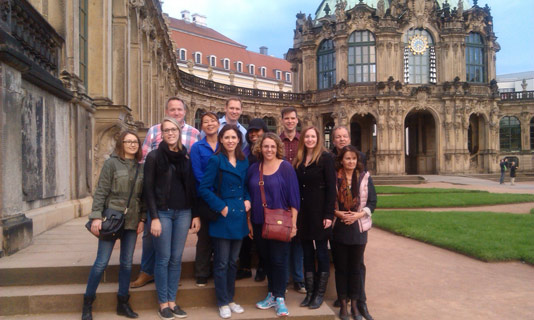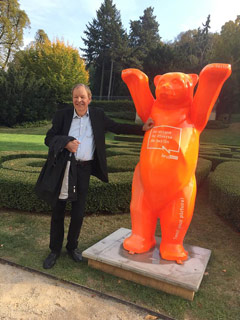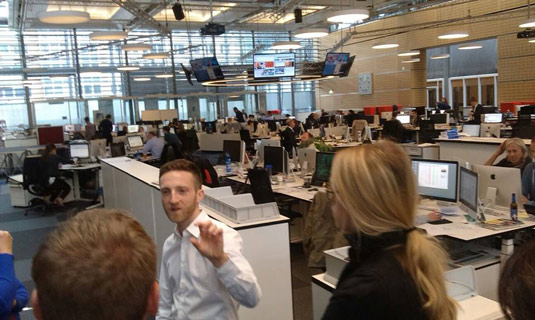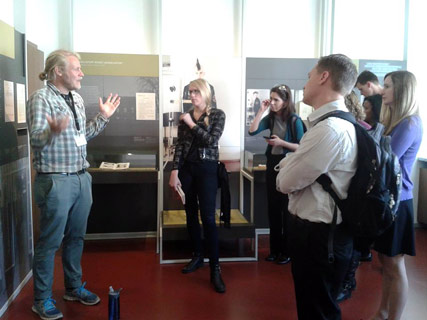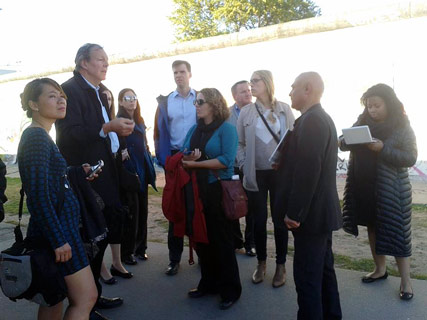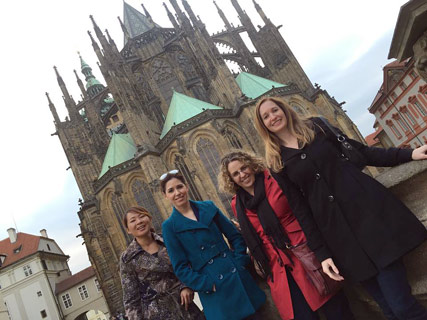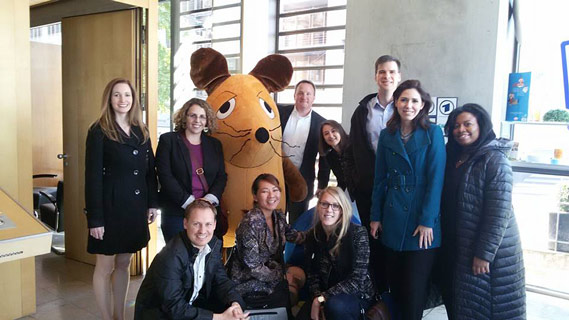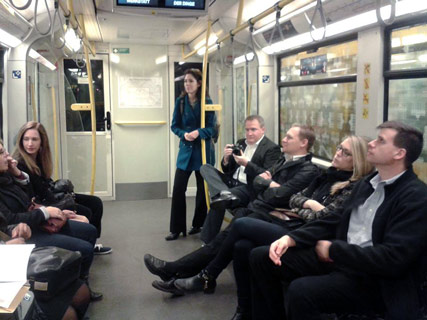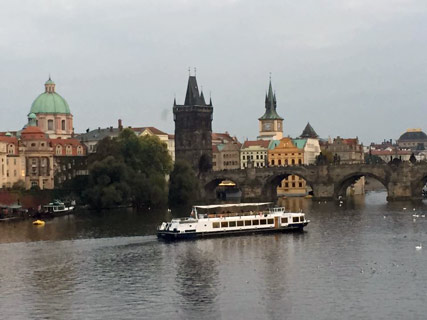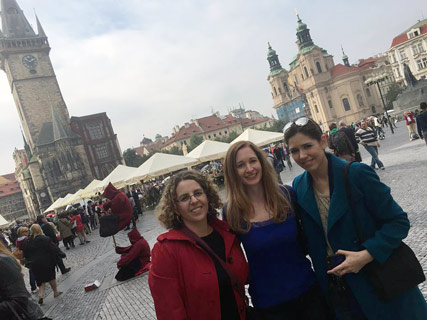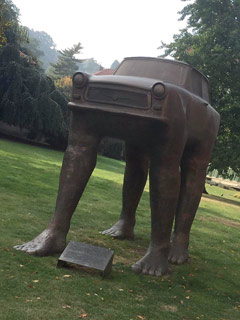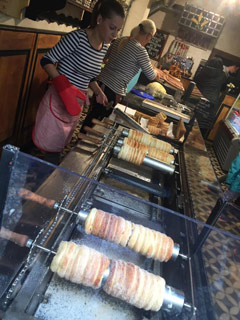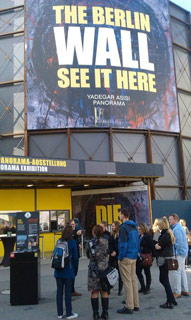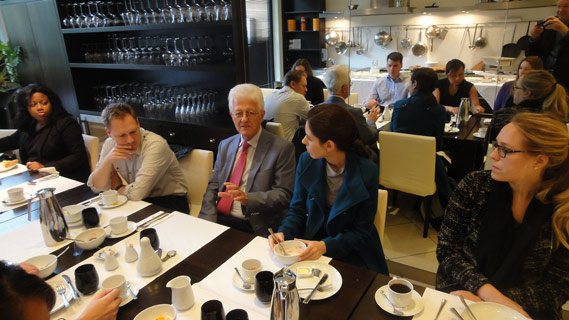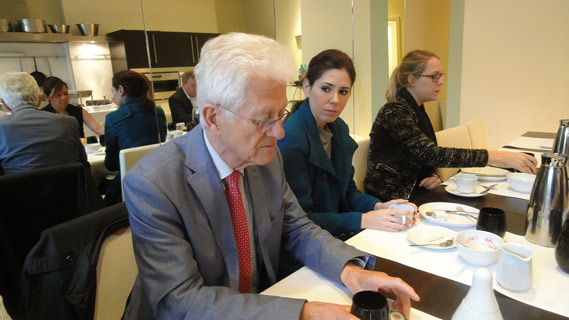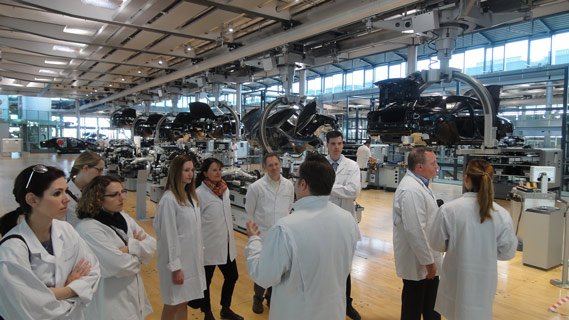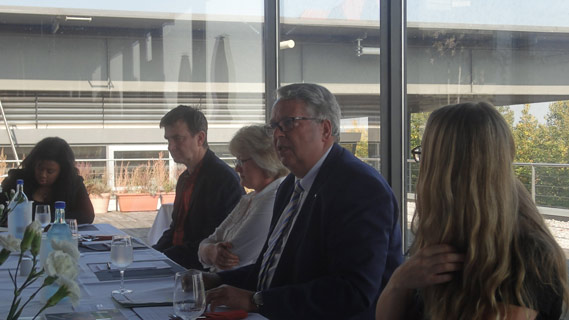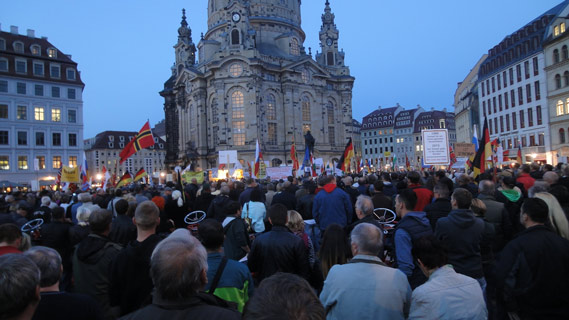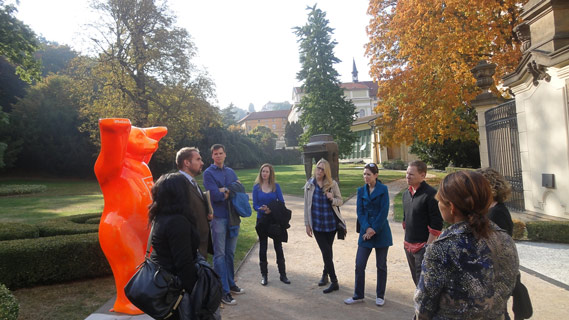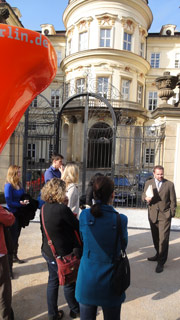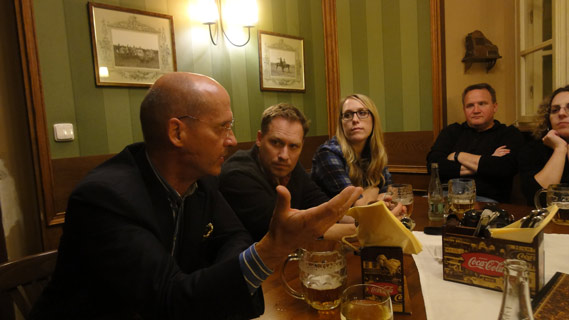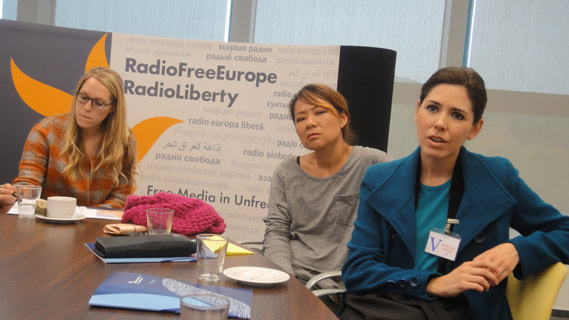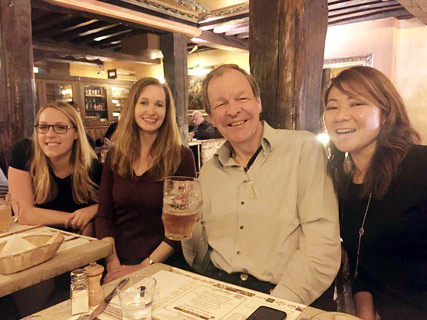TWO-WEEK GERMANY PROGRAMS 2015
Summer and Fall
RIAS Germany Program – Summer
June 15–27, 2015
Eleven U.S. journalists are participating in the Germany summer program. They spend the first week in Berlin for talks on current political, economic and media issues. In the second week they travel to Erfurt, the capital of the German state of Thuringia, to Cologne with visits of Germany’s biggest public and private stations WDR and RTL, and finally to Brussels for talks with the European Commission and with NATO.
REPORTS OF PARTICIPANTS
Vanessa Barchfield, Arizona Public Media, Tucson, AZ
When I was a young child, Germany was probably the first foreign country that entered my radar. My grandparents took annual trips there; they’d return after a few weeks bearing pins with coats of arms for me and my sister and photos of their beaming faces in front of cathedrals and rolling green fields. I still have one iconic photo of my grandpa Carl, standing proudly in front of the Barchfeld town sign (there’s a legend in my family that we all originated from that small east German town, our name changed to Barchfield upon arriving in the U.S.). He was American but wanted to be connected with the land of his own grandparents.
Years later, after my grandpa Carl was gone, I spent several years learning German — a fact which, I imagine, would have elated him. I learned the language not in Germany itself but in it’s tiny southern neighbor, Austria. After living there for seven years, I returned to my hometown and now yearn for my own roots in central Europe. And while I know Austria inside and out, Germany always remained a land of intrigue to me.
That was the reason I applied for the RIAS Germany Fellowship. I wanted a deeper understanding of the political and media landscapes and a different perspective on the country’s history.
And during the two-week program, that was exactly what I got.
While there were many highlights, a few moments will undoubtedly define the trip for me. The first of course being the highly anticipated blind date. Berlin-based radio journalists Michael Meyer and Kerstin Topp took Kurt Ming and me for a night out in Berlin. Their eagerness to show us their city, and to get to know us, was immediately clear. It was night of food and drink and talk of everything from politics to work to nightlife.
Another highlight was our trip to Erfurt. Despite the cold rain the city and charmed us all with its perfectly preserved historical architecture, its dumplings and the generosity of our host Andreas Postel.
I was struck through the trip by how close Germany feels to they chaos of Syria and to the turbulence in Russia. These events, which I read about and hear about every day, are not just news stories in Germany. They are present, imminent, permeating.
Back at home in Tucson, which feels so far and so different to Germany in many ways, people keep asking me about my trip. And I find myself telling them of those moments I’ve already described, and about our lovely hosts Rainer, Lisa and Isabell — who made us feel so at home and gave us so much insight into their country. I feel confident in saying my grandpa Carl would again be proud that I’ve forged another connection to the country that so intrigued him.
——————
Ed Esposito, Rubber City Radio Group, Akron, OH
The good folks at RIAS Berlin Kommission asked for a couple paragraphs detailing the experience from our group of participants in the 2015 Spring Program.
That’s harder than imagined.
What an eye-opener! In-depth background briefings and conversations with experts on security, the European and German economies, how the country and Europe are dealing with the influx of migration from war-torn regions in Africa and the Middle East notwithstanding the program was a continuing flood of cultural experience.
Whether one is a veteran traveler or a first-time visitor, the RIAS program proved to be a well-considered and executed slice of not only German life but also a glimpse into the everyday world European view, including their perspective on the U.S. It’s an invaluable opportunity to see ourselves not in a mirror but through the eyes of other nations leading the world — like it or not — in development and global security.
Our timing was prescient, even as you could easily make that argument to join the program at any time. With the Grexit, Brexit and impact of Russian sanctions at the forefront, our questions on the economy were timely and topical. The same with our discussions on security with Russian expansion of its military and operations in Georgia, the Crimea and Ukraine. Learning of the plight millions are facing trying to live normal lives outside of the Syrian civil war and breakdown of Libya was a story we don’t often hear with such power in the States.
Most of all, the RIAS experience proved rich and fulfilling because of the personal connections made with fellow journalists in one-on-one situations. It reinforces the tenant of RIAS programs, that by meeting and sharing our experiences we become more informed and widen our own perspectives. That certainly includes the opportunity to share the experience with our fellow RIAS Fellows.
Many thanks to Rainer, Isabell and Lisa for crafting such a wonderful agenda and program!
——————
Brix Fowler, KCTV5, Fairway, KS
My experience in Germany was a very personal one. I had traveled there with my mother several times as a child, but never to the capital. Before I even arrived in Germany it got off to an amazing beginning. I made friends with several of the other people on the trip who were on the same flight. When we finally landed and made it to the hotel our host, Rainer, greeted us at the hotel. The hospitality he and the rest of the RIAS group showed to the Fellows throughout the trip was more than I could have ever imagined.
The next day we had our first opportunity to hear from a reporter working in Germany. This was the first of many discussions we had with not only journalists but with politicians and others working within Germany. What struck me the most as a broadcast journalist was the massive amount of money that is funneled into the public television system. It was also amazing to see the differences in storytelling styles between reporters from the two countries.
But the trip was so much more than those morning and afternoon meetings. It was about going out and seeing the country for ourselves. One of the experiences that will stick with me forever was the trip to the Buchenwald concentration camp. Though I was deathly ill that day, it was an experience that I could not afford to miss. To have a deeper understanding of the daily horrors the victims of the concentration camp endured is something that will be seared into my memory forever. The visit to the Stasi prison was also jarring but necessary to see. To get a firsthand look at how East Germans treated their fellow citizens is something I will think about for a long time.
While the trip was intense at times, it was also so much fun. Walking around and experiencing the various cities with my fellow Fellows was probably the most enjoyable part of these several weeks. Learning from journalists who come from different backgrounds and experiences was one that helped me grow as a journalist, but more importantly as a person. Though we only had the opportunity to spend a few weeks together, these are people I consider friends for life.
But the experience would not have been complete without the RIAS group, led by Rainer, who helped organize this amazing trip. More than just getting us from point a to point b, they gave us a deeper understanding of the dynamics within Germany. This is an understanding only someone who grew up seeing the changing dynamics of the country could have given us.
I came in expecting to learn more about German journalism and culture and to have a good time. But it ended up being so much more than that. And while I have traveled throughout the world, this was by far my favorite trip. The people and places ( and the beer) I experienced while on the RIAS trip were beyond belief. I am so lucky and thankful to have had to opportunity to experience it.
——————
Nana Karikari-Apau, CNN, Atlanta, GA
My visit to Germany and Belgium was a great learning experience. My goal was to learn as much as I can about Europe, especially Berlin, a city filled with rich history and many tourist attractions. That being said, below are just a few information I learned and historical places I visited during my time in Europe.
Berlin Wall: The History Mile along the course of the Berlin Wall is a four-language information system. It provides information at 30 stopping points on the history of the partition of Berlin, and the construction and fall of the Berlin Wall. With the aid of photographs and texts, it describes events that took place at each location an which illustrate both everyday life in the divided city and the political situation at the time. Berlin Wall History Mile is to be continued, primarily along the course of the rear barrier.
After the city was divided, the Brandenburg Gate, the former city gate and emblem of Berlin, found itself just behind the border in the Soviet sector. Pariser Platz was part of the border strip and therefore inaccessible to the public. It was designed to create a grandiose impression; in fact it was part of the military installation to protect the border.
At Brandenburg Gate underground station (U-55) the exhibition Mauerinformation Brandenburger Tor tells the history of the landmark as a symbol of the division and reunification of the city. The only authentic remains of the wall here can be seen at the Akademie der Künste. The East German border guards set up a command post there. The remains of cells reserved for border violators (i.e. refugee) have been preserved in the historic Academy Hall.
After occupying Berlin, the victorious powers of the Second World War divide the city into sectors — British, Americans and Soviet — that converge at Potsdamer Platz, which was largely destroyed during the war. On August 13 1961, the Soviet sector barrier runs between Potsdamer and Leipziger Platz, transforming the site into a huge wasteland in the middle of the city. Now, the two parts of the city, which were separated for decades, have visibly grown together in striking fashion at Potsdamer Platz. All the buildings, with the exception of Weinhaus Huth and the Kaisersaal of Hotel Esplanade were built after the reunification of Germany 1990. Little remains of the East German border system. Ten minutes from here, behind the houses at Leipziger Platz in Stresemannstrasse, you can look round a former control tower.
Segments of the hinterland wall can still be seen in the basement of the federal Ministry for the Environment and Nature Conservation, segments of the front wall on the northwestern side of the square form an exhibition showing the overall concept of the Berlin Wall.
From September 22, 1961, “Checkpoint Charlie was where allied border guards registered members of the American, British and French armed forces before they entered East Berlin.” Declared by the GDR leadership as the only legal crossing point for members of the allied forces, the checkpoint at FriedrichstraBe was the scene of what’s become known as the tank confrontation in October 1961.
In April 1945 the Red Army reaches the gates of Berlin, The Second World War which started by Germany and cost millions of lives comes to an end. On May 8th, the German army surrenders. The Nazi dictatorship is defeated. Germany loses its eastern territories and is divided into four occupation zones. German communists loyal to Moscow install a new dictatorship in the Soviet zone. Their power is based on the Red Army and the Soviet secret police. This is the start of a communist experiment that for many becomes a nightmare.
Hohenschönhausen: A top secret prison site is located in the Berlin district of Hohenschönhausen in the years of 1945 to 1989. More than 40 thousand people are imprisoned there in various camps and prison during that period. Their prison experiences, many of them traumatic.
The secret police in the GDR is only responsible for political crimes. Since Hohenschönhausen has been the central prison since 1947, the most important cases end up here. In the beginning its main concern was asserting the dictatorship and eliminating non-communist parties. Every form of resistance is to be stopped. After the Berlin Wall is built, mostly escapees, escape helpers and people who applied to leave the country are imprisoned here. Later, dissidents and civil rights activists are held here as well, Spies, Nazi Criminals and arrested Stasi employees are also brought to Hohenschönhausen.
Tiger Cages: In this part of the building of the prison were the so-called outdoor exercise yards of the prison infirmary. These were cell-like, roofless compartments which could be locked from the outside. Their walls are four meters high and covered over with wire mesh. For this reason the prisoners called them “tiger cages.” They were also fitted with an alarm, barbed wire and CCTV. Sentries patrolled on a metal observation bridge and kept the prisoner under constant watch from above. During their 30min exercise time, the prisoners were forbidden to stand still or to approach the wall. Talking and singing were prohibited. The interrogator could reduce or cancel outdoor exercise at any time. The main outdoor exercise facility of the investigative custody prison had 12 compartments and was situated behind a building.
New Building: This was a U-shaped three-storey building that was the East German Ministry for State Security (MIS) central investigative custody prison from 1960 to 1990. Prisoners from the neighboring Labor Camp X built it in the late 1950s. It consists of a cell wing and an interrogators’ wing which are directly connected. The building was also connected to the old building, where department XIV, the MFS unit responsible for the investigative custody prisons, had its headquarters, as well as to the six-storey office building behind it of Main Department IX, the so-called investigative organ of the State Security Service. The building had more than 200 cell and interrogators’ rooms. Detainees were brought into it via a special double security gateway for vehicles. Their personal details were recorded in a photography room. In a magistrate’s room they were informed that an order had been given for their detention. In the cellar of the building was the prisoners’ kitchen and a section for female prisoners who had already been sentenced and were employed in the running of the prison. Two rubber-lined cells served “calm prisoners down.” Behind the building there were 12 outdoor cells where prisoners were taken for open-air exercise.
Adolf Hitler: With the appointment of Adolf Hitler as Chancellor on January 30, 1933, the National Socialists assume power. They blame the February 27 burning of the Reichstag building on the communists, rescind basic rights and establish the first concentration camps. The Parliament now meets in the Kroll Opera, where the so-called Enabling Act on March 23, 1933 passes with a majority. With this legislation Parliament deprives itself of its own powers. At this decisive moment only the Social Democratic Party votes against this Act, the seats of the Communists are empty; most of them have already been arrested, have fled to other countries or have gone into hiding. Members of the SPD parliamentary group have also been arrested or face repression and intimidation. On September 1, 1939, Hitler began his war for “Lebensraum”-increase living space for Germany. This meant a new phase or repression for those excluded from the people’s community. The persecution of these “internal enemies” was largely the responsibility of the Reich Security Main Office in Berlin. This central authority for the Nazi terror also organized the mass murder of millions of people in occupied Europe. Its task was to suppress any kind of resistance. At first the German population, especially the Berliners, saw the war as a rapid series of victories. The food provision system worked, and the few air raids on Berlin failed to undermine confidence in victory. As the war went on there were isolated protests that were relentlessly prosecuted. By 1943 Berlin was clearly showing the effects of war. Goebbels launched the slogan “Total war — shortest war,” aimed at boosting the population’s will to hang on and its readiness to join the war effort. Forced laborers kept up armaments production in Berlin. In 1943 the allied air attacks started to alter the cityscape. Innumerable buildings lay in ruins, many thousands of people were homeless and public life gradually began to collapse. Berlin surrendered on May 2, 1945, six days before the end of the war in Europe.
Cecilienhof Palace: Cecilienhof Palace was built in the style of an English manor house from 1913 to 1917, it was the last palace built by the Hohenzollern family. Designed by Paul Schultze-Naumburg, it served the family of Crown Prince Wilhelm as a residence until 1945. It was named after his wife Crown Princess Cecilie. The building contains 176 rooms that are now used as a museum and a hotel. The palace became famous when in summer 1945, from July 17 to August 2nd, U.S. President Harry S. Truman, Soviet Premier Jossif W. Stalin, the British Prime Minister Winston S. Churchill and his successor Clement R. Attlee met there for the Potsdam Conference. The conference room with its well-known round table, the studies of the delegations and the planted star in the courtyard have been preserved as a historic site. The restored private chambers of Wilhelm and Cecilie on the upper floor show the exquisite interior decoration and give an impression of an early 20th century palace.
War and Genocide in Eastern and South-Eastern Europe: In August 1939, Hitler and Stalin agreed to partition the Polish state and defined their respective “Spheres of interest” in Europe. Germany invaded Poland on September 1, 1939. He ensuing war in Eastern and South-Eastern Europe, Germany consciously disregarded moral standards and its obligations under international law. Vilified as “inferior”, the Slav population sustained severe losses as a result of the war and brutal oppression by the German occupiers. The speedy occupation and the dissolution of state structures also meant that millions of Jews were at the mercy of the Germans.
The path to the mass murder of European Jews: In Summer 1941, the attack on the Soviet Union presented the antisemetic National Socialists with the new opportunities. Various police units murdered Jews behind the front in mass shooting operations. At the same time, plans were formed to also deport Jews from the West to the East. The security Police, headed by Reinhard Heydrich, had the responsibility for these plans. Many of those deported from Germany, Vienna, Prague and Luxembourg between October 1941 and the period just before the Wannsee Conference were shot dead upon arrival at their destination. Most were sent to ghettos. The construction of small extermination sites began during this time. In January 1942, the murderers gained experience of mass killing using diesel fumes at the dead camp near Chelmno (Kulmhof). At the Auschwitz dead camp, they killed Jews who were unable to work and Soviet prisoners of war using the pesticide gas cyclone B.
——————
Ann Klaus, TAMU European Union Center, College Station, TX
PROGRAM ORGANIZATION
The program was superbly planned and executed. Rainer, Lisa and Isabell were on the ball, were organized, and a pleasure to hang out with for the two-week program. They were also patient with the RIAS Fellows! I appreciated the time and effort the RIAS staff put into producing the program for the group. It was filled with high-quality briefings, gave a good view of both important history and current events, and was also infused with cultural education.
PROGRAM AGENDA
The agenda was laid out with a nice balance of briefings, covering general and specific content areas, plus meetings with the media and also activities that allowed the group to learn about not only Berlin’s history and current environment, but also Germany’s on a broader scale.
The biggest thing I came away with was a much more in-depth understanding of the key issues facing Germany, and the EU at this time. For me, as someone who works at an EU Center in the United States, getting first-hand information from professionals who are “on the ground” and dealing with the issues facing Germany and the EU was exceptionally fantastic. I could not have learned so much if I had not had the opportunity to participate in this program. The briefings not only provided me with a greater understanding of how key issues, including the financial situation, immigration and security, are being addressed, but also allowed me to develop ideas for seminars and conferences the EU Center at Texas A&M University could host in the coming year. I have already spoken with the EU Center director, Dr. Guy Whitten, about some ideas and he is interested in seeing if it might be possible to invite some of the people we met with to Texas A&M to speak this academic year. I also valued learning about the current status of issues impacting the united Germany.
Rainer kicked off the program with a fantastic overview of Germany’s recent history and how that has impacted the city of Berlin during the last decade. And provided a good overview of the private/public infrastructure of the news world in Germany.
The briefings from media professionals Thomas Walde, Thomas Habicht and Krik Kirschbaum, and military experts Karl-Heinz Kamp at the Federal Academy for Security, and Andrew Budd at NATO were the most outstanding and valuable briefings. Walde and Kirschbaum did a wonderful job of setting the stage for learning about the German media audience and the key issues at play for German and EU society today. Hearing first hand from media professionals that in Germany, “news isn’t a commercial enterprise, it’s a necessity for democracy to avoid propaganda” was stunning. It was quite a contrast to the U.S., where news broadcasting is often presented with a value-based bias or a political opinion slant. And often there is a heavy personal slant to political news. It was also very impressive to learn how much more educated and interested citizens within Germany are about current news and politics. Many U.S. citizens do not make an initiative to become informed about politics and critical national issues, and often ignore media, or approach what they hear or read with great scepticism because they feel the networks present biased news. Because I do not work in the broadcasting field, I learned a great deal from discussions about how the age market is driving German broadcasters to evaluate news platforms and media formats for different audiences. It was also intriguing to discuss the issue of privacy protection, and how one’s values about privacy are impacted by the past history of a country. Though I knew a lot about German-US ties during the war and reunification, I felt hearing about these important historical events from the perspective of locals was valuable. I also gathered new insight into inter-EU politics and issues that impact the social and governmental structures of EU countries.
Karl-Heinz Kamp at the Federal Academy for Security, and Andrew Budd at NATO both gave utterly fantastic presentations about current and future security issues and challenges. It was so impressive that someone of Mr. Dr. Kamp’s professional stature would take the time to present such an organized and informative briefing on security issues in Germany and the EU as a whole. This coupled with Mr. Budd’s briefing at NATO on security issues from an EU perspective was amazing. While hearing these experienced and informed men talk about security challenges and issues facing the nation/EU/world was a bit frightening, it was also incredibly valuable.
It was an exciting time to be in Europe, and specifically in Germany and Brussels, during the time when the status of how the Greek debt would be handled was being addressed. Thanks to RIAS, our group was given a unique opportunity to gain an unbiased understanding of what is going on in Germany, as well as throughout the EU. And, this is so important to our global understanding of the health of Europe and how it impacts us globally!
——————
Andrew Mach, PBS Newshour, New York, NY
I’m so grateful that I was able to participate in the RIAS program in Germany. The experience was both rewarding and eye-opening, and I am confident that I took back with me plenty of valuable information that will enhance my work at PBS NewsHour in New York. The RIAS program in Germany and Belgium was an eye-opening experience.
Generally speaking, one of the best things about the way the program was structured was that we got amazing access to numerous speakers who each had their own presentation to make and information to give. The best part of that was that the group was really able to steer the direction of the conversation down whatever path we wanted based on our questions and interactions with the speaker. And that information was particularly valuable because it was through their particular lens of intelligence.
It was also nice that there was a certain element of tourism and historical perspective built in to the program. The tours of the Berlin Wall Museum, the Stasi Prison, the East Side Gallery, Buchenwald and others were extremely valuable because they offered context to other presentations in the program, and they had a different vibe that broke up the threat of monotony from the day-to-day activities.
Regarding the presentations and speakers in particular, I’m very happy to have learned more about the differences in the journalism between the United States and Germany. I’m continually fascinated and confused by the German media structure. The 50/50 private and public model seems very complex. The fact that ZDF Morgenmagazin switches its programming with ARD every other week, for example, appears like it would be sort of unseemly for both the journalists and the viewers. Still, I was able to see the logic behind the system when various speakers explained the nuances of it. The presentations with ZDF, Deutsche Welle and RTL were extremely helpful.
Something I found very helpful was that it was very apparent to me that journalists in Germany — particularly digital journalists — struggle with many of the same things that journalists in the U.S. struggle with. The problems of retaining viewers, attracting younger viewers and promoting work are universal.
However, it does seem that the focus of how either country would go about combating those problems is different. In the U.S., I find that much of the job of a journalist focuses on social media as a way of promotion. Sharing your work across social media platforms is now built in to the process of reporting and publishing. And that step is extremely important in the U.S. because it’s where the younger viewers who will consume your brand in the future will come from.
In Germany, while much of the above is also true, I found there to be less of an emphasis on social media, namely Twitter. When Thomas Walde of ZDF spoke about their model, he mentioned that Twitter is important, but it hasn’t quite yet reached a fever pitch or been a key way to find an audience for ZDF programming.
The experience I found the most valuable was the blind date night with German journalists and former RIAS Fellows. My date was with Liane Gruß and Kristin Joachim from Germany and Marielle from the U.S. The night was an excellent way to tailor the RIAS experience to what exactly I wanted to know. And because both Liane and Kristin were younger, I felt comfortable speaking with them about anything. I would definitely keep this element of the program for future Fellows.
Another experience I found particularly valuable was the trip to NATO headquarters in Brussels. While not all three speakers were entirely engaging, I found the information presented to be extremely important and relevant from a foreign policy perspective. I don’t often cover foreign news in my job, and I would have to devote special research to foreign issues if I were going to report on them. But after the NATO talk, I have much more confidence simply speaking about foreign policy issues. I would also urge that this element of the program be kept in for future Fellows.
I have already and will continue to recommend the RIAS Fellowship for other American journalists. It was a fantastic trip and one that even someone without a foundation on German history or current affairs could benefit from. Thank you very much for the opportunity.
——————
Margaret Mazzetti, Associated Press, Washington, D.C.
I can’t recommend the RIAS Fellowship program highly enough and I believe it speaks volumes that it’s a program driven largely by recommendations and word of mouth in the journalism community. Most, if not all of the Fellows on my trip had heard about the opportunity through friends or colleagues, or had been involved with it for quite some time.
That being said, it’s difficult to boil down two weeks of immersion in a country’s history, politics and culture. In the weeks leading up to the trip, I brushed up on my German history and boarded the flight hoping to learn more about the Greek crisis, Germany’s anti-immigration movement and its dependence on Russian gas, particularly in light of recent events in Ukraine.
My experience was so much more.
For one, history is very much alive in Germany. No one can deny the country has left its mark on the world. Berlin is littered with important World War II and Cold War-era sights, many of which we were fortunate to visit as RIAS Fellows. But this shared experience and understanding of the past shapes much of the policies and discourse of the present. Through our many conversations with members of the media, I learned that Germans are especially concerned with privacy issues because of the spying and wiretapping that went on under the Nazi regime’s Gestapo and later the Stasi. Not only did news of the National Security Agency’s wiretapping of Chancellor Angela Merkel’s phone net more coverage in Germany than in the states, I found out that it’s also illegal to take photos of strangers on the street without first obtaining their permission.
Throughout the trip, it was clear that the timing of our visit could not have been better planned. Each day, we received in-depth briefings on a host of pressing topics including ongoing negotiations with Greece, Russian aggression in Georgia and Ukraine, and concerns over terrorist cells operating in the country. We even heard from a Syrian refugee who was trying to navigate life in Germany with his family after many failed attempts to get there. Our visit to the European Commission coincided with high-level council meetings and we missed Defense Secretary Ash Carter’s speech at NATO by only a few days.
To top it all off, we each got to spend an evening in Berlin getting to know a German journalist. My “date” and I spent the better half of six hours swapping stories and discussing American foreign policy, the future of the European Union, and social safety nets in the United States.
I couldn’t have asked for more from the RIAS Fellowship and know that I will maintain the personal and professional connections I made well into the future. Thanks to Rainer, Isabell, Lisa, and the rest of the RIAS Berlin Kommission for such an amazing opportunity!
——————
Kurtis Ming, KOVR-TV, Sacramento, CA
I recall limited world history lessons in high school, and only seeing an occasional news report about Germany in the local newscast and paper. Being a RIAS Fellow allowing me to travel to Germany, opened my eyes giving me the opportunity to see the sites, and hear from the people whose lives were shaped by the historical headlines I’ve read. I walked away enlightened learning how far Germany has come in just decades, how jobs of journalists differ, the country’s concerns for its future and I now understand the German perspective on privacy which frankly was confusing before arriving.
As a journalist in the United States, we demand government transparency and expose flaws in society that need improvement. Prior to my visit, I didn’t fully understand why the German media would experience a backlash for releasing the name of a pilot who murdered passengers and crew members by intentionally crashing a plane. As we met with journalists, government officials, leaders, and toured a political prison, I realized the answer lies with the scars Germans still have decades following the government’s brutal treatment of its people. Families were torn apart as the government spied on its people, tortured and murdered them, and made up lies.
While the NSA has been controversial at home, it also became clear why Germans, especially families impacted by the Stasi seem even more upset with the United States over the program. However, we learned the very program many German’s despise is responsible for stopping attacks against Germany.
In a well-organized and carefully crafted tour set up for our fellows, the trip opened up with a tour of the Berlin Wall. To stand along a wall that divided suppression from freedom for decades and to hear the stories of families ripped apart, and of those who died trying to see a relative or a loved one again, was quite sobering. Seeing the pictures and hearing the individual stories of those taunted fenced in from freedom gave me a new appreciation for the life I’ve known.
Based on the people we spoke with, it seems Germans have no interest hiding the details of its troubled past. The day we toured a well-preserved concentration camp was fittingly cold, rainy and miserable giving us just a tiny sliver of a taste of the horrible conditions the thousands who died there felt in their final weeks and months. Seeing the disturbing images of lifeless emaciated bodies stacked up before touring the very ovens that cooked bodies is something that will live with me forever. Tricking people into thinking they were getting a health exam, only to put a bullet in their head exposed me to the calculate cruelty that existed in Germany. These calculated efforts against humanity are something Germans want the world to know and learn from.
I walked away fascinated by the difference in news coverage. While the United States media are largely for profit, the German broadcasters supported by public money and overseen by commissions have stayed on track covering mostly the important news that matter. With ratings pressure in the United States, and fewer people relying on TV and radio for news, our media have felt the need to morph into covering what people would rather watch, versus what they should know.
Looking forward, I am much more knowledgeable of the Russian threat to the world. We learned about the challenges NATO faces and its over reliance on the United States which so often is despised for flexing its muscle in parts of the world. We learned if the United States sat back, Europe which geographically is neighboring the biggest threats, could be an even bigger target. While the United States government has clearly made mistakes along the way that it seems to have trouble admitting, I heard from officials commending our efforts even if they haven’t been popular among European citizens.
I commend RIAS for keeping its mission alive even after the radio broadcasts ended. It’s an invaluable program that broadens perspectives. It certainly did for me and will make me a better person and journalist for it.
——————
Andrew Schneider, Houston Public Media, Houston, TX
There is a word in Hebrew, “Aliyah,” which translates as “the act of going up.” Jewish people living in the Diaspora who immigrate to Israel are described as making Aliyah. More commonly, the term is used to refer to the act of going up to the front of a congregation to recite a blessing before the reading of a passage from the Torah. Being called up to the Torah for an Aliyah is a tremendous honor, a public recognition of acceptance in and responsibility for the Jewish community.
On Saturday, June 20, I was called up for an Aliyah at the Neue Synagog on Berlin’s Oranienburger Straße. The building had been desecrated by the Nazis on Kristallnacht, damaged and burned by Allied air raids, and suffered decades of neglect under Communist rule. Most of the original congregation perished in the Holocaust. Yet here I was in the midst of a small but thriving Jewish community. It was one of the most moving spiritual experiences of my life, and I have RIAS to thank for it.
I was fortunate to visit Oranienburger Straße several times toward the end of my week in Berlin. By chance, this was the neighborhood where my “blind date,” Markus Wacket of Reuters, first lived when he came to Berlin as a journalist more than twenty years before. The district is now flourishing, full of handsome apartment buildings and thriving restaurants, but Markus was still able to point out where dingy tenements — and, in one case, a brothel — had stood when he arrived soon after the Berlin Wall fell. Following Markus around, I reflected that all that first week I’d been crisscrossing the former path of the Wall, between Kreuzberg and Mitte on either side. The regeneration of the latter was so thorough that, apart from a few remaining slabs, such as at the Berlin Wall Memorial or the East Side Gallery, it was hard to tell the city had ever been divided.
Once we’d settled in at Markus’ favorite restaurant, we spent the next two hours talking about stories of major concern to Germany, all of which had been frequent points of discussion with the journalists and political figures with whom the RIAS Fellows had med throughout that first week — the unfolding Greek debt crisis, the conflict between Russia and Ukraine, the Energiewende. We spent a fair bit of time discussing the Transatlantic Trade and Investment Partnership, comparing how the widespread German concerns about TTIP mirrored concerns many Americans hold about the Trans Pacific Partnership.
We also spoke at length about the 2016 U.S. presidential contest, with Markus asking my thoughts on the chances of the dozen-plus candidates who had already declared. The RIAS group’s visits to the Bundestag and to the Thuringian representation in Berlin had left me with the sense that the main U.S. political parties could take a lesson from Germany’s about how to work across the aisle to achieve common ends — or at least how to maintain civility in their opposition to one another. I marveled, and still marvel, at how the SPD is able to balance a partnership with the CDU in the Bundestag and a coalition with the Greens and the Left in Erfurt. It has been many years since Republicans and Democrats have been able to cooperate in this fashion in the U.S. Congress and state governments.
Erfurt and the surrounding area provided what for me were some of the most enduring images of my fellowship. I had fully expected this would be the case with Buchenwald, the first concentration camp I had ever visited. Much as I tried to steel myself, nothing could have prepared me for the experience of entering the crematorium and coming face to face with ovens. I am thankful to have had the opportunity to recite the mourner’s Kaddish prayer at the memorial wall in that horrific building.
The contrast with Erfurt proper could scarcely have been starker. The guided tour of Erfurt Altstadt felt like I’d stepped back in time more than five hundred years, which only made sense to me when our guide explained that the Allied air forces had largely spared the city from the bomb damage and fires that had leveled Berlin — and, as I later saw, Cologne and Hamburg. The half-timbered buildings on and near the Krämerbrücke were among the most beautiful structures I’d ever seen. I was so taken with them that, when I returned to Houston, one of my first actions was to visit a paint store to match the pastel yellows, blues and greens of my Erfurt photographs. The colors now decorate the walls of my new home.
My only regret is that, during the group’s brief stay in Erfurt, I was not able to make time to visit the city’s Old Synagogue beyond the brief viewing during the walking tour. It’s one many reasons why I hope my RIAS Fellowship will be only the first of many visits to Germany.
——————
Marielle Segarra, WHYY Radio, Philadelphia, PA
The RIAS Fellowship was an incredible experience. Over three weeks, I visited more than ten cities, met with security advisors at NATO, toured some of Germany’s most important historical sites, and had so many pretzels, half liter beers, and Thuringian dumplings that I thought I might explode.
What I appreciated most about the trip was that I had an opportunity to get to know another country much more intimately than you do when you only visit for a few days.
One thing that stuck out about Germany was that history is ever present, especially in Berlin. Only a couple decades ago, the city and the country were split into two. That means that a significant number of Germans remember what it’s like to live in a surveillance state, often just a step away from prison or death.
Visiting Hohenschönhausen was particularly affecting. I read a few books about the Stasi before coming to Berlin, but I wasn’t prepared for what we saw that day. My stomach turned when we walked into the building, saw the padded cells and transport vans, and heard about how the Stasi tortured citizens of the GDR. It’s easy, and tempting, to say this history is behind us. But as our guide pointed out, many countries still use solitary confinement and torture as a form of punishment.
As a couple of our speakers pointed out, the East Germans’ experience living in a surveillance state has changed the way the country approaches privacy. I was surprised to learn that you have to ask permission to snap a photo of someone in a public space. That’s not the case in the U.S. (and if it were, the paparazzi probably wouldn’t exist).
It’s also clear that the memory of the Holocaust and WWII still looms over Germany. The country has done a thorough job of memorializing the horrors that took place before and during the war.
Buchenwald was too horrible to process. The camp was bitterly cold on a summer afternoon, so I can only imagine what it was like during the winter. One thing that stuck with me was that the locals weren’t ignorant of the atrocities happening there. They condoned, and even participated in the humiliation, torture, and murder of the prisoners.
I could barely sleep the night after we left. I kept seeing shadows on the wall, and thinking of all the people who were killed at Buchenwald. People who had their lives stolen from them. I was overwhelmed with how terrible the world can be.
The experience actually made me wonder about the value of visiting these sites. I believe Germany should maintain these memorials, to educate future generations, and to counter anyone who would say these atrocities never happened.
But for someone like me, who is well-schooled in WWII and Holocaust history, who visited Auschwitz 10 years ago and is not a Holocaust denier…what is the value in visiting, and steeping yourself in the horrors of the 1940s? Do we learn something about ourselves, or about other people, in contemplating the darkest deeds ever committed? I’m still not sure.
These were two of the most poignant experiences because they were so dark. But there were also some wonderful, positive moments.
During our “blind date” dinner, I got to see some of present-day Berlin, went to a bar that’s on the roof of a mall parking lot, and compared notes with our German hosts about traveling, our families, and their RIAS trip.
The tour of Erfurt was fascinating (I never knew how indigo was made…), and I felt like the group really started to connect the night we got there. The following day, our talk with Husein, the immigrant who made his way to Erfurt, was really personal and eye-opening.
And what a delight when we got to Belgium, the sun came out, and there was a chocolatier on every corner. I especially loved the trip to Bruges.
Our final speaker at NATO scared the life out of me regarding the situation in Russia, but he was incredibly engaging and forthcoming, and I felt like I understood the situation much better for it.
I also found unending inspiration for stories and tweets related to my project at WHYY, which focuses on distressed Pennsylvania cities and solutions to the problems those cities face. I saw parallels between Berlin’s approach to its growing immigrant population and how Pennsylvania cities deal with a similar challenge/opportunity.
In the Ruhr, I wrote about some of the coal mines that have been repurposed into public parks and cultural spaces.
In Münster and Berlin, I found that there’s real-time information at many bus stops, something a few Pa. cities are considering. I also marveled at the biking infrastructure in Münster.
And in Hamburg, I wrote about how the city turned an old freight depot into an artists’ quarter.
I will also be producing two radio features: one about Bottrop, an old coal town that’s trying to become the greenest city in its region, and the other about HafenCity, Hamburg’s mixed-use development on its former industrial port area.
I’m so grateful for the opportunity to get to know Germany, its cities, its history, and its people. Thank you to RIAS and the RTDNA for your warm hospitality and the many hours you spent planning the trip.
——————
Danielle Turner, FOX Business Network, New York, NY
As the wheels of the plane touched down in Germany, I had two countries on my mind: Greece & Russia. Given the current geo-political landscape and the two nations’ domination of the world news cycle, it felt like a good bet. But by the end of day one, I was pleasantly surprised to find I was dead wrong in that assumption. While Greece’s financial crisis and Russia’s roulette of politics both served as major conversation backdrops, the RIAS Fellowship took us beyond the main headlines, inside a broad range of economic and political issues facing Germany today.
The diversity within the program is the backbone of its success. Speakers, along with the topics tackled, varied each day, preventing any sense of overlap or redundancy. From trade policy to renewable energy to demographics, I came home with an improved, comprehensive understanding of the nation’s economic vitality. As a financial news journalist, I was provided a more thorough background and context behind the stories leading my rundown every day.
My career in TV news was built and remains grounded in the United States. Spending two weeks immersed in the German broadcast industry opened my eyes to just how different the two nations are in their coverage. Take funding for example, and you find two separate stories. Germany’s public stations are swimming in money, boasting an annual budget of over $7 billion. In the U.S., public media are just struggling to survive, and regularly face roadblocks such as government subsidy cuts. There’s also a stark contrast in the two nations’ commercial break structures. In Germany, the first 15 minutes of the program is uninterrupted, allowing for a higher, more global story count. The German stations’ unbiased approach to the stories also provides more facts, and puts the opinion in viewers’ control.
It wasn’t all different though. Adapting to the changing media landscape and viewership habits is a practice both countries are racing to perfect. Just like Americans, more and more Germans are consuming their news online, cutting the cord so to speak, and leaning on their phones to stay informed. After speaking with anchors and network heads in Berlin and Cologne, the collective understanding mirrors that in the U.S. — the industry is evolving rapidly and pivoting to digital is key to survival.
Singling out just one speaker as the highlight of the program is no easy task, but if I had to, I’d point to Mr. Thomas Habicht. He eloquently outlined the major economic risks that lie within Germany along with the lesser-known factors that are lost in the global news coverage. For example, Germany’s birthrate crisis is central when gauging the nation’s future as an economic powerhouse, yet it’s barely on the American viewer’s radar. The fact that the nation that boasts the strongest fiscal health in the entire Eurozone is grappling with a self-inflicted issue such as this is fascinating. Mr. Habicht explained with great clarity why Germans are not having children at the preferred pace, and how this trend will affect the economy going forward.
Speaking of the future, Mr. Habicht also shed light on Germany’s outlook regarding energy independence and solar power. The country has truly embraced renewable energy, with 20% of its power rooted in solar. Even more exciting, Germany is expected to be 80% powered by renewables by 2050. The nation’s acknowledgement of climate change and adoption of innovative practices is admirable and one can only hope the rest of the world follows in its footsteps.
Germany is rich with history –there is no denying that fact. From World War II to the Cold War to the fall of the Berlin Wall, this fellowship was successful in covering every layer of the national timeline. While it would have been easy to keep the focus just on the current events governing the global news cycle today, RIAS took us one step further. Between the discussions in the conference rooms to the tours on the ground, we were provided with an in-depth look at the country, both past and present, and how it fits into the international puzzle. The only way to really appreciate Germany’s role in the world today is to hold a firm grasp on the country’s past. This program accomplished that, and much, much more.
RIAS Germany Program – Fall
September 28 – October 10, 2015
Nine U.S. journalists participated in the Germany Fall Program. They spent the first week in Berlin for talks on current political, economic and media issues. In the second week they traveled to Dresden, the capital of the German state of Saxony, to Prague and finally to Brussels for talks with the European Commission and NATO.
REPORTS OF PARTICIPANTS
Natalie Angley, CNN, Atlanta, GA
John Emerson, U.S. ambassador to Germany, said it best: “This is the most interesting time to be in Germany since the fall of the Berlin Wall.” We couldn’t have asked for a more historic time to be in the country. Throughout the trip, we saw the bridging of the old and the new — in politics, journalism, culture and architecture. The graffiti left by Soviet troops that is preserved in the halls of the Reichstag is symbolic of Germany’s tragic past, but it’s also a symbol of hope in this new chapter in German history.
As the European Union faces its biggest challenge with the refugee crisis, Germany has positioned itself in the center after Chancellor Angela Merkel declared an open door policy allowing hundreds of thousands of refugees to enter the country. One of the most moving stops on our journey was at the LaGeSo registration site for refugees in Berlin. It was heartbreaking to learn that 35 to 40 percent of the migrants are children. We saw the desperation on so many faces both young and old, who stood near our group in hopes of gaining new information about their fate. The government workers were visibly overwhelmed, only able to register 100 of the 300 new refugees coming in each day. But it was heartwarming to hear of the outpouring of support from doctors volunteering to provide medical care and residents donating toys and teddy bears.
Attending the PEGIDA demonstration in Dresden gave us a first-hand glimpse into the minds of xenophobic radicals, who oppose the flow of Muslim refugees into the country. It was disturbing to hear the hate speech being spewed to 9,000 people in the square as the crowd chanted “We are the people” and “Merkel must go.” The fear must have been evident on my face when one of the male protesters walked up to me and said “Don’t be scared” in German. A small group of young people protesting against PEGIDA the night before had a clearer view. One held up a sign that read: “No brain. No heart. More room for prejudice.”
Along with witnessing the effects of the refugee crisis firsthand, having the chance to attend the 25th anniversary celebration of German reunification was a once-in-a-lifetime experience. It was exhilarating to be at the Brandenburg Gate with so many people from a formerly divided nation singing, laughing and listening to music together. Visiting the East Side Gallery with artist Kani Alavi and taking a tour of the Stasi Museum made the celebration that much more powerful. Our museum tour guide was captivating as he weaved in personal stories from the past. He described the grim reality of what life was like for many people in East Berlin—how children were taught to throw grenades in school “for fun” and how the Stasi used mental tactics like disorientation, fear and isolation to force those who were arrested to talk. He also explained how many residents in East Berlin heard about the wall coming down from RIAS.
I enjoyed meeting with German journalists on the trip and hearing how the public and private TV stations differ from those in the United States. It was interesting to learn that the oldest and most-watched newscast is the 15-minute Tagesschau that airs at 8 p.m. The show has become an institution, and as a result all prime-time programming starts at 8:15 p.m. I appreciate that politics are not sensationalized in Germany and that the focus is on the issues rather than on personalities. After returning to the states, the first news story I watched on TV was about GOP frontrunner Donald Trump preparing to host an upcoming episode of SNL, the late-night sketch comedy show.
It was fascinating to visit Radio Free Europe in Prague and learn about the journalists, who are risking their lives to broadcast in 23 non-Democratic societies. It was disturbing to hear of the growing concerns over propaganda on Russian TV. One example we saw was a TV weather report describing the conditions as “very favorable” for bombing Syria. We also heard from Ray Furlong, a multimedia editor, who is covering the refugee crisis including Syrians fleeing the violence. He described how he captured the journey of a Syrian newlywed couple on the road to a refugee camp in Europe in the mini-documentary “Desperate Honeymoon.”
Like Furlong, the refugee crisis has become the story of the year for many journalists especially in Germany. As we learned, most Germans started off welcoming the refugees. But some of that spirit has waned and public opinion of Merkel has started to dip in the polls. As Geert Mackenroth, Saxon Commissioner for Foreign Nationals, said, “Questions in the public eye are increasing. Where is the light at the end of the tunnel?” The biggest task will be integrating the migrants into society through education, employment and housing. Despite the challenges that lie ahead, I agree with Ambassador Emerson, who said, “This could be an opportunity for Germany to write a new narrative.”
——————
Steve Baragona, Voice of America, Washington, D.C.
A quarter century after East and West reunited, Germany is large and in charge. That’s one big takeaway for me from three weeks in Europe with the RIAS Fellowship.
Exactly 25 years after reunification, we saw the continent’s most populous nation and biggest economy playing a leading role in the ongoing migrant crisis. We learned that Chancellor Angela Merkel has a unique relationship with Vladimir Putin, putting her at the center of relations between Russia and the West. And I used my extension to see how Germany’s remarkable expansion of renewable energy was leading Europe’s response to climate change.
We learned how Germany’s size and economic might make it impossible for its European neighbors to ignore, but the country’s history makes it easy to resent. When Germany takes a tough line, out come the Nazi jokes.
Germans are acutely aware of their past; Berliners especially. Reminders are all around them that make sure they don’t forget. I had seen other memorials around the city before, but I was surprised to see the walls of the Reichstag deliberately uncovered to reveal graffiti left by the Russian soldiers when they took the capital from the Nazis in 1945.
I was also struck by the persistence of the emotional and cultural scars left by the Stasi and its ubiquitous spies. Anyone who grew up during the Cold War is familiar with the fact of communist oppression. But what really affected me were the stories of how, even a quarter century after the Berlin Wall fell, reading your Stasi file can throw your life into turmoil.
Now, with Germany leading a united Europe, we saw first-hand how the migrant crisis poses a new challenge to the country and the union. On our visit to the registration center, it was obvious that the hundreds of thousands fleeing poverty, wars and oppression are severely straining the country’s generous social welfare system.
It was great to see Germany — or a significant part of Germany, at least — going out of its way to take in the migrants, even as some of its neighbors do the opposite. It’s a role I wouldn’t necessarily expect for a country not usually associated with multiculturalism.
But that overlooks Germany’s enormous Turkish population. I knew there were a lot of Turks in Germany, but I didn’t realize that there were so many that Turkish politicians go there to campaign. German society has not integrated the Turks well, however, which raises questions about how this new wave of migrants will fare.
The PEGIDA march in Dresden showed that there’s at least a vocal minority who don’t want them there. It’s going to be interesting to see how 80 million Germans incorporate a million people from cultures very different from Germany’s. It’s going to take a long time, a great deal of effort and a lot of money. My impression was that the rest of Europe needs to step up, especially the new European Union members to the east. They’ve been happy to enjoy the benefits of EU membership. Now it’s time for them to take on the responsibilities. (There clearly are downsides, however, to sending migrants to countries that don’t want them.)
Lastly, my extension was a great opportunity to talk with some of the key players in Germany’s Energiewende. Given the unfortunate debate in the U.S. over the very existence of climate change, I was amazed to hear unanimous agreement that Germany will have stopped burning the most CO2-intensive form of coal by 2050. I expected Greenpeace to say that. I didn’t expect it from the trade union for mining, chemical and energy industries; nor from the association of energy and water industries. And the fact that renewables already produce a third of Germany’s electricity shows the rest of us what’s possible.
Thanks for a great trip!
——————
Ryan Burrow, WGN Radio, Chicago, IL
Three days after returning to the U.S. I was covering a story in Chicago. Illinois Governor Bruce Rauner announced he wanted the state to sell the aging, dilapidated Thompson Center, which houses state government offices in Chicago. Governor Rauner complained the building is loud, the space isn’t efficient, and there’s a constant odor from the food court.
There isn’t much love for the building among Chicagoans. Other than the state offices, a DMV, and a food court that includes a Sbarro and Taco Bell, it has lost its function to the towering high rises and street level retail built in the last couple decades.
However, there was one voice pushing back against the building’s demise. It came from its German architect Helmut Jahn. Jahn claimed the glass-paneled, round building was meant to be a symbol of “openness and transparency.” But with one former Illinois governor sitting in federal prison on corruption charges, and another just being released months ago for the same offense, the thought of “openness and transparency” among state workers triggers and eye roll among the voting public.
For me though, those words “openness and transparency” conjured up a different perspective. The Thompson Center was designed by Jahn, and built in 1985. Which means it came before the fall of the Berlin Wall; five years ahead of Germany’s reunification; and 14 years before the dome of a top the Reichstag Building would be completed under the same symbolism of “openness and transparency” in government.
I gained significant perspective in those two weeks on the RIAS program. I can tell by the way I answer the simple question…“So how was your trip?”
Here are some of the takeaways that I’ve been telling people, and things that have stuck with me since my return.
THE REFUGEE CRISIS
Our visit to the LAGeSo set the tone for the entire trip, because it did three things:
- It put us at the ground level to understand the struggle not only among refugees, but also the overworked and understaffed government officials.
- It allowed us as journalists a better angle to probe the government officials during our sessions, understanding their concerns as well as the concerns of the refugees and the public
- It gave us as Americans better insight on how immigration is being handled outside of the U.S. 24-hour news cycle, and 2016 presidential implications.
IMMIGRATION
On more than one occasion a speaker told us, “We’re not as good at handling immigration as well as you are in the U.S.” The comments gave me pause. Do we handle immigration well in the U.S.? Many Republican presidential contenders are basing their campaigns solely on tighter immigration, erecting walls, and strengthening securing. Meanwhile liberals appear ready to grant amnesty to millions without giving serious consideration to integrating different cultures and languages. The days of ships of immigrants coming into Ellis Island are over. And the thought of building a wall like one that divided East and West Germany seems symbolically destructive to Emma Lazarus’s poem affixed to the Statue of Liberty, “Give me your tired, your poor, your huddled masses yearning to breathe free…”
WHO IS PUTIN?
In the U.S. the Russian president is either considered a maniac, secretly readying to raise the Soviet flag, or a bully who pushes President Obama around on an international playground. But after our discussions, and the visit to NATO, the European perspective gives Putin the appearance of an isolated figure who uses chaos to create power. The international community wants to trust him, but has been burned before. Putin’s main objective is to create nationalism to mask the serious deficiencies in his country’s finances.
VOLKSWAGEN SCANDAL
While waiting for a cab following my “blind date” Vladamir Balzer and I were talking about cars, eventually landing on the VW emissions scandal. Vladamir exclaimed, “I’m just so embarrassed… We’re supposed to be known for our German engineering.”
I don’t know what the financial toll will be on the German carmaker, the auto industry, or the German economy, but clearly this scandal bruised Germany’s pride in making superior vehicles. In the U.S. a scandal like this would involve a huge public relations push back, attorneys, spin, attacks and counter attacks. But here it appears the German automaker is willing to accept responsibility and fix the problem. In the long run I think this will help the brand’s image.
EAST VS. WEST
We had great discussion on what life in Germany was like before and after reunification, including great insight on the days, months and years that followed. I think Americans assumed once the wall came down all was right with the world. But the changes did take a toll on those living in the East. Changes came fast, too fast for many. And it left a mistrust that still exists in pockets of Germany today. We asked former Berlin Mayor Eberhard Diepgen if he thought such a reunification could happen in Korea, and he said flatly, “No.” There were clearly circumstances that allowed reunification, but according to him the change may have come too quickly for the public.
IS TRUMP FOR REAL?
We got this question from many of our presenters. I loved how they wanted to know what is driving Americans, and how our political system is working. Sometimes American politics is treated like sport. But after seeing what Germany has been through in the last century, and how the country is dealing with the refugee crisis, I think we as reporters got better perspective of what issues SHOULD be driving the 2016 presidential election.
This trip gave me great respect for what Germany is doing with the refugee crisis. It gave me terrific perspective on the governance and the issues facing Europe. And it also gave me pride in being American.
My country is still looked upon as a leader in capitalism, entertainment, politics, and even immigration. I would argue to architect Helmet Jahn, U.S. government transparency doesn’t need to be in the form of a building. It’s exposed every day in our independent media. (Oh, and the Thompson Center is a dump.)
——————
Benjamin Kaiser, CNN, Atlanta, GA
——————
Allison MacDonald, MSNBC, New York, NY
Given its rich and complex history, Germany is an inherently interesting place to visit no matter the month or the year. But to visit Germany in the fall of 2015 was to witness a country — and a continent — confronting the greatest challenge in decades: the huge influx of refugees pouring across its borders. And to see it all up close as a RIAS Fellow was an unforgettable experience. Between the exposure to the on-the-ground reality and meetings with journalists and government officials, I came away from the RIAS Fellowship with a greater understanding of Germany’s challenges, its history, and its media landscape. I highly recommend the RIAS exchange program to any American journalist interested in Germany, Europe and the pursuit of international stories.
Without a doubt, the two highlights of the Fellowship were related to the refugee crisis. Within 24 hours of arriving in Germany, RIAS took us to the center of the crisis in Berlin: a refugee registration center. To schedule this visit so early into the program was a great way to frame the other meetings throughout the next few weeks. When we arrived at the camp in Berlin, hundreds of refugees were crowded around, waiting to register. The official who spoke to us gave us a clear and candid picture of the situation she and her staff were facing: there simply weren’t enough of them to handle the massive influx of people arriving, some 10,000 each day. Another highlight of the Fellowship was the visit to a PEGIDA protest of up to 9,000 people in Dresden. Although I had been reading about PEGIDA and their weekly protests, to witness one was a chilling experience, as protesters chanted against Merkel and the asylum-seekers. Experiencing the demonstration just days after seeing the plight of these refugees in Berlin helped demonstrate the scope of the challenge facing Germany.
Another lasting impression from the RIAS Fellowship was learning about Germany’s media landscape and how it differs from America. One of the most striking contrasts was how much Germany invests in its public broadcasting and the effect that has on the quality of news coverage. I couldn’t help but think how different the political debate in America would be if we had to pay a monthly fee for public television. The many visits with radio, digital and television journalists from both public and private outlets gave me a good sense of what it’s like to be a journalist in Germany. It was especially interesting to hear from journalists’ experience of German reunification, and to go on our “double date.”
The meetings throughout the two week Fellowship were wonderful, but one of the things I enjoyed most about the trip was that we actually got to experience the four dynamic cities we visited: Berlin, Dresden, Prague and Brussels. Whether it was the visit to the Reichstag in Berlin, a guided tour of Dresden, eating Czech dumplings or Belgian waffle — it was great to be able to roam and discover these cities outside meeting rooms and television studios and embassies.
Lastly, while much of this trip was about the issues, the friendships I formed as a RIAS Fellow are invaluable. Rainer, Lisa and Isabell were not only incredibly helpful, but also wonderful people; and getting to know a group of American journalists from across the country was such an incredible experience. I would recommend this program to any American journalist eager to cover international stories and learn about German culture. Thank you, RIAS!
—————
Irene Noguchi, KQED Public Radio, San Francisco, CA
Walls. The world seems filled with walls.
- The Berlin Wall, which fell in 1989.
- The “walls”/borders that migrants have to cross.
- The “walls” rising between Germany and other countries, who are hemorrhaging migrants and expecting Germany to provide relief.
Everywhere, there are walls.
This entire RIAS trip has been about walls.
We arrived in Germany at a very unique time. I feel no other group of RIAS Fellows has arrived at such a confluence of events: the flood of 800,000 refugees, the weekly anti-migrant PEGIDA marches in Dresden, the 25th anniversary of German reunification, the Volkswagen emissions scandal… all while geopolitical tensions burn hotter in the countries around us (e.g., Putin’s airstrikes in Syria, Hungary’s use of tear gas and water cannons on asylum seekers, and the Ankara bombings in Turkey). We are seeing walls/borders falling under the tide of migrants, political walls being built, and nationalistic walls rising between German residents and their new migrant neighbors. I believe we are the first RIAS group to see the pros & cons so starkly: visiting a LaGeSo refugee registration site (where Syrians and Iraqis fleeing war and reprisals crowded around us, hungry for any help we could provide), and later standing amidst PEGIDA protestors who chanted old Nazi rally songs and who cheered when PEGIDA leader Lutz Bachmann denounced migrants over the loudspeakers. We are seeing history firsthand. And while we are journalists, and our job is to record that history, it also makes me incredibly sad to see the same tensions that once pushed apart West and East Germans, Nazis and Jews, resurfacing today in new forms.
But how do we as journalists interpret these walls? We’re taught that walls are bad things, barriers that separate people from loved ones or from pursuing better lives. But they also provide a sense of safety: to keep invaders out, to define our borders, to protect us. The PEGIDA demonstrators feel walls protect them from outsiders, protect them from migrants taking their homes or jobs, or the benefits they worked so hard for. As one woman told me at the PEGIDA demonstration, “These outsiders come in, and they take take take!” She was a smiling, sweet-faced middle-aged woman. She loved her four children. She lived in a small town near Dresden. She did not seem “evil” or “crazy,” as some PEGIDA demonstrators have been called by the media and other Germans. But “people are afraid of the unknown,” Geert Mackenroth told us. He’s the Saxon Commissioner for Foreign Nationals, a judge who thought he would retire to Tuscany, but found himself called back to duty to help foreigners integrate into Dresden and the Saxony area. He has the tricky job of helping the 5% of refugees sent to Dresden reacclimatize (when two-thirds have no profession), AND of balancing public opinion & quelling fears (amidst thousands showing up every Monday for PEGIDA marches). He was going to local assemblies and meetings. “I try to give them facts and figures,” he said. “But fear isn’t only a matter of people’s minds, but of people’s emotions. And it is very difficult to fight emotions.”
The migrant situation seems to be a mire of emotions. German reporters tell me that Angela Merkel’s decision to welcome 800,000 refugees wasn’t a political one, but a moral one. That even though it could cost her political clout, the woman who grew up in East Germany knew what it was like to be a “foreigner” struggling in a new land after the Berlin Wall fell. “She decided with her heart,” one reporter told me. But that emotional decision has brought repercussions: She’s fallen from #1 to #4 in the polls, her political CSU cohort Horst Seehofer called her decision a “mistake,” some groups are trying to have her decision legally reversed, PEGIDA marchers are waving anti-Merkel signs, and countries like Hungary and Italy continue pushing their migrant flows into Germany. What one leader sees as “right,” is also what others interpret as very, very “wrong.”
There is no clear black and white. But the decision has been made, and now Germany is struggling to responsibly navigate the consequences. Every official we spoke to on our RIAS trip seemed at a loss for how Germany would integrate all these refugees into workplaces, housing and schools. And no integration can be entirely seamless. (Even in modern Germany today, 25 years after reunification, as speaker Thomas Habicht told us, people are reading their Stasi files for the first time and weeping upon discovering their friends’ betrayals. A woman who grew up in East Germany still bristles when West German colleagues make a casual joke about East Germans.)
But in Germany, it seems the best route to begin to even tryto solve any problem is transparency.
After the legacy of the Holocaust and the secrecy of the Stasi, the Germany I see today places a priority on transparency. The walls of the German parliament (the Bundestag) are made of glass. The Stasi archives are open to anyone who requests their files. German media is very self-critical, and most Germans are extremely well-informed, watching the Tagesschau TV report every night at 8 p.m. And Germans’ shame and outrage over VW’s emissions scandal speaks volumes.
People do not want to repeat the mistakes of the past, and the Germans I meet seem to feel transparency is the key. It’s much harder to retain walls if you can see through to the other side, and understand the other’s perspective. You can’t negotiate (or even begin to report) on a situation without at least trying to empathize with other viewpoints.
And these very walls we’ve been seeing (between nations, between residents and migrants, between East and West Berlin), they’re not clearly black and white. Walls are fluid, constantly changing things, continuously open to interpretation and influence.
The more I learn on this RIAS trip, the more I find that you cannot “tear down” a wall. Destroying a wall is not an instant solution. It does not erase the years to come of resentment, anger, and grief.
I admire Chancellor Merkel for her bold decision, and the courage it took to step forward and take responsibility for millions of people when no other capable nation would do the same. But based on everything I have learned this trip, it will be a long, tough road ahead…not only for integrating refugees into Germany society, but acclimating German residents to their new neighbors.
As I stood among the PEGIDA marchers in Dresden, quietly observing one man wave a poster (a drawing of a Muslim woman shooting herself in the head), a question kept nagging me: How did these same Germans, once refugees from East Germany or far-flung countries, now firmly close the door in other refugees’ faces?
It’s a question I suspect I will continue to struggle with as the refugee crisis unfolds. But if anything, this RIAS trip has taught me that as journalists, we must view a situation through multiple perspectives. We mustn’t limit ourselves to just the New York Times and NPR, but include ARD, Deutsche Welle, and France 24. We must see the story first-hand. We must try to hear the voice of the German mother worried about how her four children will compete for future benefits, as well as the voice of the Syrian refugee standing in line at a Berlin registration site, clutching his red ticket and wondering when he will be admitted.
We can report on PEGIDA marchers, but we can also report on a group of Dresden students dressed up as zombies, mocking the PEGIDA demonstrators.
I have no doubt the migrant crisis will bring many new walls — physical, social and emotional.
But as a journalist, I’m beginning to learn we can break down those walls with our only chisel: information. It’s a slow process, but I’m hoping it’s a worthwhile one.
——————
Katie Orr, Capital Public Radio, Sacramento, CA
I was fortunate enough to be included in the RIAS Fall 2015 trip. It was an incredible experience. When I got there I didn’t know what to expect. Would my group be nice? Would the sessions be interesting? Would I learn things I could carry with me into other reporting experiences? The answer to all these questions was a resounding yes.
From the first night I knew it was going to be a great trip. Crowding into a traditional Berlin pub with seven other Fellows, I felt an instant connection. Everyone was smart, talented and invested in making it a worthwhile trip.
The sessions proved to be just as satisfying. I’m a political reporter by nature so most of our appointments were right up my ally. It was fascinating to learn how Berlin functioned while the wall was up. And I felt very lucky to be in the city as Germans celebrated reunification. In addition, being in Germany while the country is dealing with a refugee crisis was an amazing experience. In America we of course see images of refugees on the news. But seeing it in person was an entirely different thing. To me it really brought home the point that everyone is basically the same. Everyone wants a decent life where they are safe and respected. It’s easy to forget that when you don’t meet people in person.
In general I found the German people to be very aware of their past and conscious of not repeating the bad parts of it. I do wonder how all of Europe will cope as the refugee situation continues. Along those lines I’m so happy the Fellowship included several sessions on the crisis. It was interesting to hear how different news organizations are covering it. I thoroughly enjoyed the trip to Radio Free Europe. I got the sense they are really trying to own the story. Covering the crisis and seeing how others are reporting on it was truly my favorite part of the trip.
That being said, I also thoroughly enjoyed traveling to the other cities. I was surprised by how charming Dresden is. And I really enjoyed hearing the perspective of those working at the European Commission and NATO. In the United States we tend to just focus on what our country is doing. I think that is mostly a result of being isolated from other countries. But it was interesting to learn how Europe as a whole approaches different problems. Hearing different perspectives on issues like Russia, gun control and even the funding of public broadcasting reminds me there are a multitude of perspectives in the world.
Overall it was a fantastic trip. I found our hosts to be friendly, fun, knowledgeable and extremely gracious. We were truly treated like honored guests the entire time we were there, which just made the trip so enjoyable. I look forward to reporting from my home station with a broader perspective than I had before I went on my Fellowship.
——————
Hilary Powell, Lakeshore Public Media PBS, Indianapolis, IN
I am a PK. That is Christian, colloquial code for preacher’s kid.
As the long-time stepdaughter of a Christian pastor, I often wear my faith rather close to my heart. “Let not kindness and truth leave you; bind them around your neck, write them on the tablet of your heart,” says Proverbs 3:3, one of my favorite Bible passages.
Religion aside, these two values, truth and kindness, are good ones to have when traveling anywhere abroad. They are even more vital to hold close as a journalist. Along my RIAS Fellowship journey, I learned it was important to be wide open: open to new ideas, cultures, food, and to lead with kindness. I also learned that it is important to listen to others’ truths.
My PK-status meant I was somewhat attune to the notions around faith and belief while in Germany. It was a thread that colored my journey from bustling Berlin to mythical Dresden, over to the cobblestone streets of the Czech Republic and then to bold Brussels, Belgium.
Each destination echoed something about history and how belief was either shaped or silenced there.
At the Topography of Terror, just steps from my Kreuzberg hotel in Berlin, I read how the Nazi regime so careful planned the extermination of an entire ethno-religious group.
While trotting from the S-Bahn train line in Berlin’s Spandau neighborhood, I was staring at the ground and not the cute, crisp eateries, on an ocular mission. My co-fellow Alison put me on to searching for stolperstein. After falling behind our walking group, my dallying paid off. I spotted a cluster of the gold commemorative stones, inscribed with the names of Holocaust victims. My group doubled back to take a look. It was so humbling to pause for people likely persecuted by the Gestapo or SS for their faith.
In the shadows of the alabaster, arisen-from-ashes Frauenkirche in Dresden, Germany, I stood toe-to-toe with the statue of Martin Luther, father of the Protestant Reformation.
I learned some 60 percent of Germans are members of a Christian denomination according to recent studies. Seated overlooking the banks of the River Elbe, I also learned from Mr. Geert Mackenroth, Saxon Commissioner for Foreign Nationals, that the xenophobic group PEGIDA typified as a minor, not major voice of Saxony. “Dresden is not PEGIDA,” Mackenroth said.
The timing of my trip to Berlin could not have been more impeccable given the refugee crisis. It was moving to visit LaGeSo, the first site of registration for asylum-seekers mostly from Syria. But our trip was given context from Thomas Volk, an expert on Islam at Konrad-Adenauer-Stiftung. He explained that five percent of Germans are Muslim… but a hearty 57 percent of Germans say they think Islam is a threat to their country. He described the integration of incoming refugees, along as the next hurdle the EU must tackle as whole.
Along those lines, I was also witness to how Europe addresses intolerance. At European Union headquarters, EU Commission spokesperson Natasha Bertaud so firmly said “religion is not allowed to be a factor” in the relocation of the more than 600,000 refugees who’ve entered the EU.
So, faith flowed as a natural theme for me on this journey. It was my own litmus test for making sure I was always observing more than coming to a definite conclusion.
I am just using faith as one example to illustrate how I explored one topic so many ways while on my RIAS Fellowship. I loved that each stop along our journey added color to the full tapestry. That is the benefit of this vital program. It promotes German-American understanding by giving you in full cultural immersion.
It was really a blessing to be accepted. My recompense would be a journey I cannot possibly sum up. It would come off as a litany of cliché-shattering experiences that I had during my month abroad. To hover too long over any memory brings on immediate nostalgia for a country I have only known for a year’s time.
I am ever thankful to Mr. Rainer Hasters, Ms. Lisa Ziss, and Ms. Isabell Hoffmann for their dedication to forging transatlantic friendship.
Now, I also learned about practical things useful to my craft. As an anchor and managing producer most recently for a Chicago PBS station, I was fascinated for example, by the fact that public television leads the media landscape in Germany. Yet, I am a story-seeker at my core, so the cultural and social experiences in Europe are what gripped me. They reminded me to approach storytelling by looking for a common ground.
Now that I have told you about the faith faculties of my heart (you know, that truth one never strays too far from reporters,) it’s inevitable I add another inhabitant: Germany.
How do you sum up a course-changing journey? You don’t. You can only pack the moments into your soul experience and use your appreciation to help fuel more understanding. If you ask any of my co-fellows to sum up their experiences, these wordsmiths may well go mum. Rather than risk big rhetoric, they will probably just tell you to go, run, and apply.
Because it is more than an honor to be counted among the more than 1400 curious citizens that now call themselves former RIAS alum. I feel blessed to join that transatlantic vanguard.
Someone once told me grace is doing for me what I could never do and what I will never deserve.
Thank you, RIAS, for your grace.
——————
Maya Rodriguez, KUSA TV, Denver, CO
It’s one thing to watch world events unfold on television. It’s quite another to see it for yourself.
Such was the case for the 2015 RTDNA/RIAS Berlin Commission fall Fellows, who got an up-close view of how all countries are, in the end, inextricably linked to one another.
It started in Berlin, with our first glimpse of the unfolding humanitarian challenges linked to the migrant crisis. Our visit to LaGeSo, the human and social services agency, is something that will stay with me forever. Hundreds of people were waiting there, looking to Germany as their salvation from war and despair. They held on to the numbers they were assigned much like one holds on to a life raft. You could see their aspirations for a better future were staked on that number. They waited for days on end in the hopes their number would be the next one called.
We saw the other side of it, too — from those who do not welcome the migrants and would rather see them repatriated. That came during a PEGIDA march we attended in Dresden, where thousands of people protested in the streets, demanding an end to Germany’s welcoming stance towards the migrants. There was anger among those in the crowd and it was palpable. While approaching the protest from several blocks away, I could hear the muffled sound of someone speaking through a microphone and then a great roar of approval from the crowd. It sounded eerily like what can be heard in historic footage reels in Germany from just before WWII. It sent chills through me.
In some ways, the division seen in Germany over the migrant issue is not that much different from what the United States has in dealing with its own immigration issues. “Immigration reform” is often talked about in political circles and there are deep divisions about what to do with the 12 million undocumented people living in the U.S. However, while those issues have built up in the U.S. over the course of decades, in Germany, the migrant influx is relatively new. It will be interesting to see how Germany deals with the migrants who settle in the country and whether they will be truly integrated into greater German society.
Another interesting takeaway from the Fellowship was how “public television” has a different place in German society, when compared to the U.S. I find it fascinating that public television carries the most watched newscasts in Germany, whereas in the U.S., commercial television stations are the dominant force. There also seems to be a greater concentration in Germany on covering international news. In the U.S., most stories tend to have a domestic focus. Considering the U.S. has such a strong international presence, I’ve always found it odd that we don’t have more overseas news bureaus and more coverage of world events. It’s nice to see that German television stations appear to value global coverage.
In all, the Fellowship provided a priceless opportunity to see the workings of Germany, and the EU as a whole, as they try to deal with the migrant crisis and other issues. The other Fellows on this trip, along with the incredible RIAS Berlin staff of Rainer, Isabell and Lisa, made this trip so memorable. I know I have made friendships that will last beyond our time in Europe — and that was truly the best part of this Fellowship.

